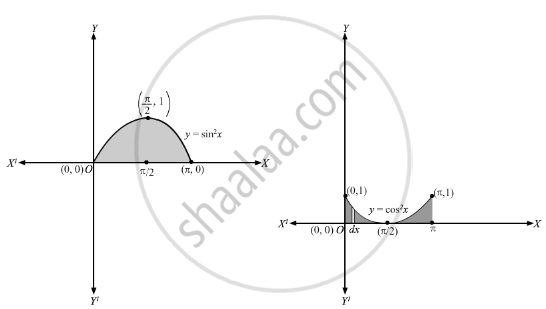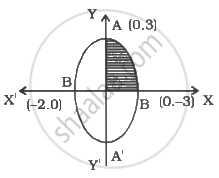Advertisements
Advertisements
प्रश्न
Compare the areas under the curves y = cos2 x and y = sin2 x between x = 0 and x = π.
उत्तर

|
X |
0 | \[\frac{\pi}{4}\] |
\[\frac{\pi}{3}\]
|
\[\frac{\pi}{2}\]
|
\[\frac{2\pi}{3}\]
|
\[\frac{5\pi}{6}\]
|
\[\pi\]
|
|
\[y = \cos^2 x\]
|
1 | 0.5 | 0.25 | 0 | 0.25 | 0.75 | 1 |
|
\[y = \sin^2 x\]
|
0 | 0.5 | 0.75 | 1 | 0.75 | 0.25 | 0 |
Let A1 be the area of curve \[y = \cos^2 x\text{ between }x = 0 \text{ and }x = \pi\]
Let A2 be the area of curve \[y = \sin^2 x \text{ between }x = 0\text{ and }x = \pi\]
Consider, a vertical strip of length \[= \left| y \right|\] and width \[= dx\] in the shaded region of both the curves
The area of approximating rectangle \[= \left| y \right| dx\]
\[\text{The approximating rectangle moves from}x = 0\text{ to }x = \pi\]
\[ A_1 = \int_0^\pi \left| y \right| dx\]
\[ \Rightarrow A_1 = \int_0^\pi y dx ..................\left[ 0 \leq x \leq \pi , y > 0 \Rightarrow \left| y \right| = y \right]\]
\[ \Rightarrow A_1 = \int_0^\pi \cos^2 x dx\]
\[ \Rightarrow A_1 = \int_0^\pi \left( 1 + cos 2x \right) dx .................\left[ \cos^2 x = \left( 1 + \cos 2x \right) \right]\]
\[ \Rightarrow A_1 = \frac{1}{2} \left[ x + \frac{\sin 2x}{2} \right]_0^\pi \]
\[ \Rightarrow A_1 = \frac{1}{2}\left[ \pi + \frac{\sin 2\pi}{2} - 0 \right]\]
\[ \Rightarrow A_1 = \frac{\pi}{2} \text{ Sq . units }\]
Also,
\[ A_2 = \int_0^\pi \left| y \right| dx\]
\[ \Rightarrow A_2 = \int_0^\pi y dx .................\left[ 0 \leq x \leq \pi , y > 0 \Rightarrow \left| y \right| = y \right]\]
\[ \Rightarrow A_2 = \int_0^\pi \sin^2 x dx\]
\[ \Rightarrow A_2 = \left[ \frac{x}{2} - \frac{1}{2}\frac{\sin 2x}{2} \right]_0^\pi \]
\[ \Rightarrow A_2 = \frac{\pi}{2} - \left( \frac{1}{2}\frac{\sin 2\pi}{2} \right)\]
\[ \Rightarrow A_2 = \frac{\pi}{2} sq . units\]
\[ \therefore\text{ Area of curves }y = \cos^2 x\text{ and area of curve }y = \sin^2 x \text{ are both equal to }\frac{\pi}{2}\text{ sq . units }\]
APPEARS IN
संबंधित प्रश्न
Find the area bounded by the curve y2 = 4ax, x-axis and the lines x = 0 and x = a.
triangle bounded by the lines y = 0, y = x and x = 4 is revolved about the X-axis. Find the volume of the solid of revolution.
Find the area of the sector of a circle bounded by the circle x2 + y2 = 16 and the line y = x in the ftrst quadrant.
Using integration, find the area of the region bounded between the line x = 2 and the parabola y2 = 8x.
Find the area lying above the x-axis and under the parabola y = 4x − x2.
Draw a rough sketch to indicate the region bounded between the curve y2 = 4x and the line x = 3. Also, find the area of this region.
Determine the area under the curve y = \[\sqrt{a^2 - x^2}\] included between the lines x = 0 and x = a.
Sketch the graph y = | x + 3 |. Evaluate \[\int\limits_{- 6}^0 \left| x + 3 \right| dx\]. What does this integral represent on the graph?
Find the area enclosed by the curve x = 3cost, y = 2sin t.
Find the area of the region in the first quadrant bounded by the parabola y = 4x2 and the lines x = 0, y = 1 and y = 4.
Find the area of the region common to the circle x2 + y2 = 16 and the parabola y2 = 6x.
Find the area of the region bounded by \[y = \sqrt{x}, x = 2y + 3\] in the first quadrant and x-axis.
Prove that the area common to the two parabolas y = 2x2 and y = x2 + 4 is \[\frac{32}{3}\] sq. units.
Find the area of the region bounded by the curves y = x − 1 and (y − 1)2 = 4 (x + 1).
Find the area bounded by the lines y = 4x + 5, y = 5 − x and 4y = x + 5.
Find the area of the region enclosed between the two curves x2 + y2 = 9 and (x − 3)2 + y2 = 9.
Using integration, find the area of the following region: \[\left\{ \left( x, y \right) : \frac{x^2}{9} + \frac{y^2}{4} \leq 1 \leq \frac{x}{3} + \frac{y}{2} \right\}\]
If the area bounded by the parabola \[y^2 = 4ax\] and the line y = mx is \[\frac{a^2}{12}\] sq. units, then using integration, find the value of m.
If the area enclosed by the parabolas y2 = 16ax and x2 = 16ay, a > 0 is \[\frac{1024}{3}\] square units, find the value of a.
Find the area of the region bounded by the parabola y2 = 2x and the straight line x − y = 4.
If the area above the x-axis, bounded by the curves y = 2kx and x = 0, and x = 2 is \[\frac{3}{\log_e 2}\], then the value of k is __________ .
The area bounded by the parabola y2 = 4ax, latusrectum and x-axis is ___________ .
The area bounded by the curve y2 = 8x and x2 = 8y is ___________ .
The area bounded by the y-axis, y = cos x and y = sin x when 0 ≤ x ≤ \[\frac{\pi}{2}\] is _________ .
Find the equation of the standard ellipse, taking its axes as the coordinate axes, whose minor axis is equal to the distance between the foci and whose length of the latus rectum is 10. Also, find its eccentricity.
Find the area of the region bounded by the curves y2 = 9x, y = 3x
Find the area of the region bounded by y = `sqrt(x)` and y = x.
Draw a rough sketch of the region {(x, y) : y2 ≤ 6ax and x 2 + y2 ≤ 16a2}. Also find the area of the region sketched using method of integration.
Draw a rough sketch of the given curve y = 1 + |x +1|, x = –3, x = 3, y = 0 and find the area of the region bounded by them, using integration.
The area of the region bounded by the y-axis, y = cosx and y = sinx, 0 ≤ x ≤ `pi/2` is ______.
Area of the region bounded by the curve y = cosx between x = 0 and x = π is ______.
The area of the region bounded by the circle x2 + y2 = 1 is ______.
Using integration, find the area of the region bounded between the line x = 4 and the parabola y2 = 16x.
Find the area of the region bounded by the curve `y^2 - x` and the line `x` = 1, `x` = 4 and the `x`-axis.
Find the area of the region bounded by the ellipse `x^2/4 + y^2/9` = 1.
Let f(x) be a non-negative continuous function such that the area bounded by the curve y = f(x), x-axis and the ordinates x = `π/4` and x = `β > π/4` is `(βsinβ + π/4 cos β + sqrt(2)β)`. Then `f(π/2)` is ______.
Make a rough sketch of the region {(x, y) : 0 ≤ y ≤ x2 + 1, 0 ≤ y ≤ x + 1, 0 ≤ x ≤ 2} and find the area of the region, using the method of integration.
